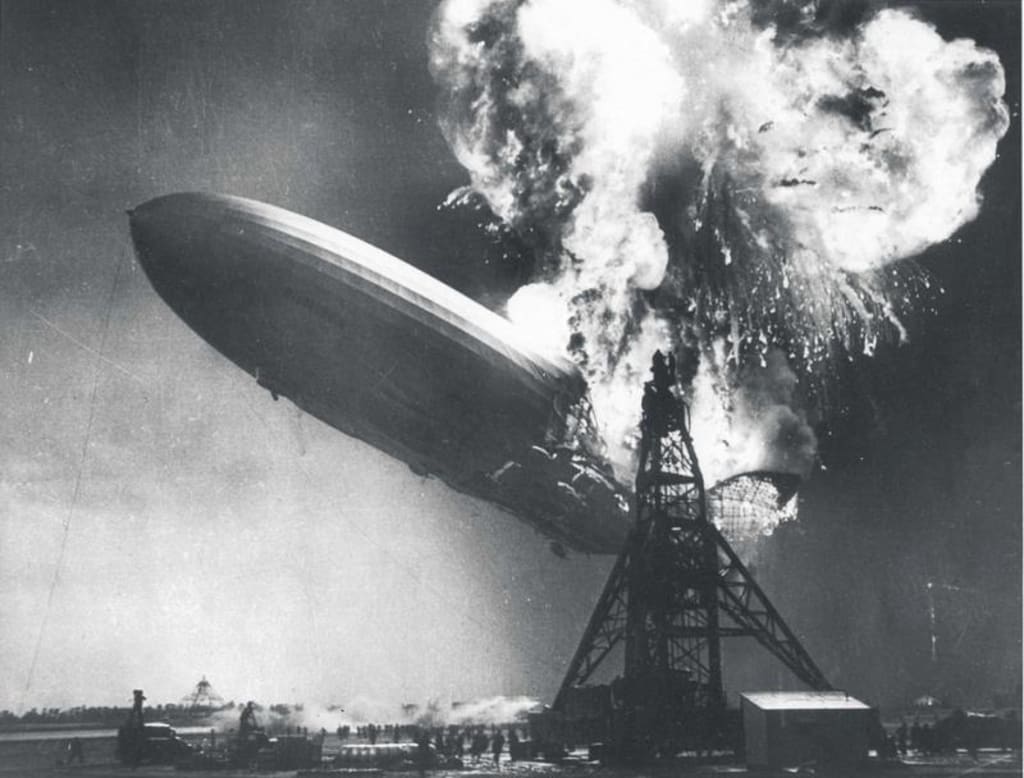The Hindenburg Disaster, 1937
This dramatic event put paid to mass transit by airship

During the years preceding World War II there were two choices on offer to those who wished to travel by air. There were fixed-wing, propeller-driven aircraft, and there were airships. Given that the former were primitive by modern standards, being noisy, cramped and uncomfortable, not to mention dangerous, it is understandable that people who could afford to travel long distances by air were attracted to the much greater comfort offered by airships, although safety was still an issue.
Airships and zeppelins
The rigid-framed airship was the invention of Count Ferdinand von Zeppelin, an aristocratic German general who, in 1895, patented a design for a cigar-shaped balloon, filled with hydrogen gas, to which engines and a cabin could be attached, thus making it far more manoeuvrable than standard balloons that could only go where the wind blew them. Not surprisingly, the rigid airship became known as the zeppelin.
During World War I, Germany used zeppelins as weapons of war, mainly for reconnaissance but also for carrying out bombing raids on London, but after the war the zeppelin was developed as a means of luxury travel. It was American interest that was mainly responsible for this, with orders being placed for bigger and better airships to fly across the Atlantic and beyond.
Passenger services between the United States and Europe began in 1930, with the vast “Graf Zeppelin” airship taking pride of place. This was 776 feet long and was capable of flying anywhere. However, in 1931 an order was placed for an airship that would be even bigger and more luxurious. This was the “LZ 129 Hindenburg”, which entered service in 1936.
This was the age of the great ocean liners that transported the rich and famous in considerable luxury from one side of the “Pond” to the other, but even the fastest liners took the best part of a week, or even longer, to do so. There was therefore a market for a means of transportation that was just as luxurious but faster, even though a modern traveller would not consider four days for a journey from Germany to New Jersey to be particularly rapid.
The Hindenburg
The Hindenburg was massive, being more than 800 feet long and 130 feet in diameter. In size it was nearly as big as that other ill-fated transatlantic voyager, RMS Titanic. The cabin that was slung beneath the gas balloon (which consisted of 16 separate cells) could carry up to 72 passengers and had a crew of around 50. There was a lounge in which entertainment was provided at a grand piano, a promenade deck, a dining room, a smoking room, and sleeping accommodation in two-bunk berths that resembled sleeping compartments on long-distance rail trains. The whole thing was powered by four huge diesel engines.
The one great drawback for the Hindenburg was that the gas used to fill the balloon was hydrogen and not helium, either of which would have given the required lighter-than-air lift. The United States was the only country in the world that could supply helium gas in sufficient quantities, and, since the rise to power of the Nazis in 1933, such supplies were off-limits to the Hindenburg’s German owners. Instead of travelling thousands of miles slung beneath an enormous bag of inert helium gas, the passengers had no choice but to trust their safety to a similar quantity of highly inflammable hydrogen.
The end of the Hindenburg and travel by airship
The flight that arrived on May 6th, 1937, at Lakehurst airfield, New Jersey, was the victim of this arrangement. As the airship reached the tower to which it was to be moored before the passengers disembarked, something caused the hydrogen gas to ignite. The fire ripped through the gas envelope from rear to front in just over half a minute, causing the passenger cabin to fall to the ground.
Although the disaster killed 35 of the 97 people on board (there was also a casualty among the ground crew), it is noticeable that the majority survived. This was largely because the blaze was very rapid and the flames soared skywards, so that the passenger accommodation was not touched. As the aircraft broke free from its mooring, the as yet unburned gas still provided enough lift during that short time for the fall to the ground to be relatively gentle, thus making the impact survivable for most of those on board.
The cause of the fire has never been conclusively determined, but the arrival of the Hindenburg coincided with an electrical storm, and it possible that the highly charged atmosphere at the time caused a spark within the metal framework of the airship which would have been enough to ignite the vast quantity of hydrogen gas.
This was a very public disaster because this particular landing was filmed and a radio commentator gave a live broadcast of the event. The dramatic scene therefore became the subject of newsreels that were seen all across America and Europe, as were the still photographs that were splashed across the front pages of newspapers across the world.
There had been other airship disasters in the past. The loss of the British R101 in 1930, which crashed in France with the loss of 48 lives, had put an end to British interest in airships as a mode of international travel. The United States now followed suit given that the inherent dangers of massive airships had become apparent to everyone.
The world would soon be at war, during which time civilian air transport ceased to be a priority for most nations. When the war ended, the development of fixed-wing passenger aircraft made massive strides, especially when jet engines became generally available, so the era of airships such as the Hindenburg could be allowed to slip into history without many regrets.
About the Creator
John Welford
I am a retired librarian, having spent most of my career in academic and industrial libraries.
I write on a number of subjects and also write stories as a member of the "Hinckley Scribblers".






Comments
There are no comments for this story
Be the first to respond and start the conversation.